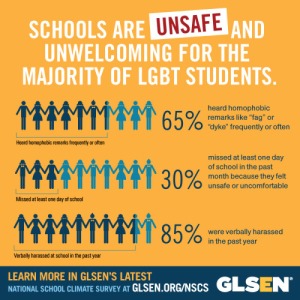According to the 2013 National School Climate Survey (www.glsen.org/nscs), conducted by The Gay, Lesbian & Straight Education Network (GLSEN), 55.5% of lesbian, gay, bisexual and/or transgender students feel unsafe at school because of their sexual orientation, and nearly 40% feel unsafe because of their gender identity. Nearly 3 out of 4 students report being verbally harassed in the past year, and about 1 in 6 were physically assaulted because of sexual orientation. 61.6% of students who reported an incident said that school staff did nothing in response. Almost 1/3 missed at least one entire day of school due to feelings of unsafety. These statistics support a clear conclusion: schools are unsafe and unwelcoming for LGBTQ students. GLSEN’s mission is to work towards safe spaces in school for all students, regardless of sexual orientation, gender identity or gender expression.
I began working for the Baltimore chapter of GLSEN in high school as a student volunteer in 2005. GLSEN’s mission spoke to me for several reasons. As a young, openly gay and proud individual, I knew that much of my pride and confidence was correlated with the amount of support I received from my friends, family and teachers. Every young person deserves to feel supported in the way that I did, and through GLSEN, I am able to work on that.
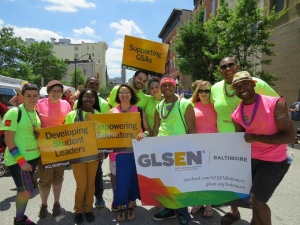
GLSEN Baltimore at the 2014 Baltimore Pride Parade
Today, I happily serve as Co-Chairperson and Education Manager for GLSEN Baltimore. I manage all educational programming for the chapter, including student presentations, professional development training for educators, and GSA support. My job, in many ways, is activism! Participation in this course allowed me to pursue a work objective concurrently with school. For my activist project, I worked to create 6 new GSAs in areas of most need: Baltimore City and rural areas of Maryland.
LGBT students who attend a school with an active GSA reportedly feel safer than those who attend schools without a GSA (NSCS). Having an official space within the school where youth can come together in solidarity and action is powerful; GSAs are, in my opinion, one of the best ways youth can be supported in school. During my junior year of high school, several students and I initiated Towson High’s first successful gay-straight alliance, and experienced how important and mutually beneficial the club became to all of its members, regardless of orientation or identity.
A large part of my job today is supporting existing GSAs and working towards creating new ones. Typically, in order to start a new extracurricular group within a school, a small group of interested students must be united with an adult staff member who will sponsor, or advise, the club. There are a few ways that we, as GLSEN Baltimore, can help to facilitate this process:
- Working with a school to host an open interest meeting for teachers and students who want to learn more about GSAs. Often, these meetings help to identify and motivate students who would like to start a GSA, and help to unite the students with an advisor.
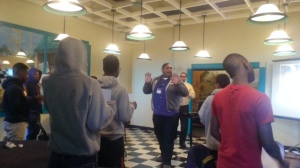
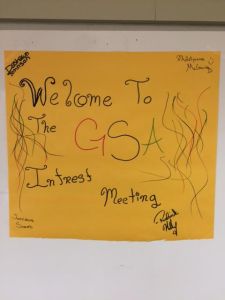 Directly informing educators about the importance and power of GSAs at trainings and events, or with mass mailings, to hopefully motivate them towards starting the conversation with students at their school. We vow our support throughout the entire process.
Directly informing educators about the importance and power of GSAs at trainings and events, or with mass mailings, to hopefully motivate them towards starting the conversation with students at their school. We vow our support throughout the entire process.- Connecting with youth in the community at events, and offering the idea of starting a GSA at their school, with our support.
- Giving telecommunicative support to teachers and students who would like to start a GSA. This includes providing ideas, language, and guidance for how the club should start.
I wanted to target Baltimore City and rural areas of Maryland because resources for LGBTQ youth and diverse school programming are especially scarce in those places. I specifically focused on Baltimore City, Carroll County, Washington County, Southern Maryland, Western Maryland and the Eastern Shore.
As I worked on the project, I came across several barriers:
- Geographically, it would be difficult to manage and schedule support for each site.
- Much of the action that can happen depends on constant and reliable communication between myself, students, teachers, and administrators.
- Balancing a full-time workload along with full-time school enrollment demands working on many projects at once, and leaves few unplanned moments.
The events that happened in Baltimore regarding Freddie Gray, together with these barriers, helped me to learn an important lesson about activism—sometimes, activism requires sacrifices, evaluation, and compromise. Activism comes with a price, and requires recognition of one’s own personal limitations. On April 28th, the Tuesday following the riots in Baltimore, I felt charged to assist with clean-up efforts in the city rather than attend class. I immediately had to consider that I had already missed a considerable amount of class during the semester in order to work on other projects. Missed class time translates into poor grades, and at this point in my life, school is more important than ever. I made the decision to attend class. During that car ride to school, I felt an entire palette of emotions. I realized that I was learning an important lesson about myself, and an important lesson about activism.
To adjust, I decided to focus my efforts geographically closer, which would remedy two of my barriers. This way, I could more easily attend meetings and follow up in-person if need be. I did not discontinue projects in other counties, but decided not to pursue new ones.
As of today, I am proud to say that I have helped to create 5 new GSAs in Maryland, including the first ever middle school GSA in Baltimore County and the first GSA ever in Washington County! New groups were formed at Sparrows Point Middle School in Edgemere, MD, Augusta Fells Institute of Visual Arts in Baltimore, MD, Renaissance Academy in Baltimore, MD, Coppin Academy in Baltimore, MD and Barbara Ingram School for the Arts in Hagerstown, MD. Aside from forming new groups, I was also able to reach out to existing GSAs in 14 of Maryland’s 24 districts, speaking to over 2,000 students and visiting over 30 middle and high schools during this past school year. Below is a video done by the students at Sparrows Point Middle.
I am still pursuing new groups at several other schools around Maryland, including Oxon Hill High, Vivien T. Medical Arts Academy, National Academy Foundation Middle, and Hampstead Hill Academy. The activism doesn’t end with this project!
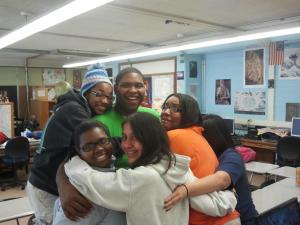
Me with members of the GSA at Baltimore Polytechnic Institute!
What worked:
- Following up and staying in constant communication with students and school staff.
- Being able to easily drive to the school to attend meetings.
- Being knowledgeable about the ins and outs of GSA creation.
- Relying on GLSEN resources, such as the JumpStart Guide for GSAs (glsen.org/jumpstart).
- Realizing limitations and making adjustments.
What didn’t work and what will change for next time:
- Being unrealistic about what could be accomplished given the amount of time.
- Waiting for students or school staff to take initiative—sometimes you have to reach out to them!
- Not having more help—you can’t do it alone! I could have used a network of capable volunteers to spread this work around to more areas.
If you are interested in becoming a volunteer with GLSEN Baltimore, or would like to learn more about the work that we do, check us out at www.glsenbaltimore.org, or find us on Facebook at www.facebook.com/glsenbaltimore !

